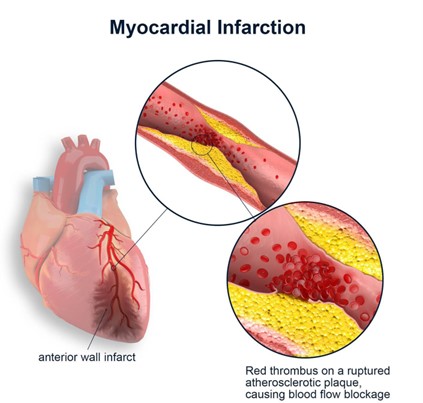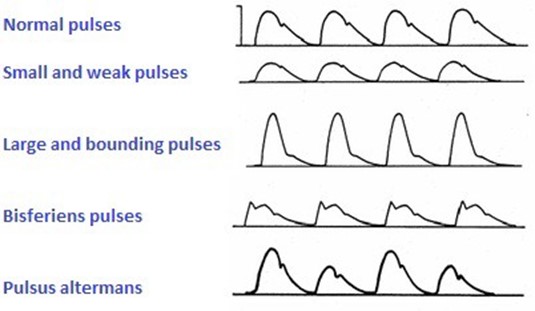The practical nurse (PN) is caring for a client with coronary artery disease who is admitted with intermittent chest pain. The admission laboratory results indicate elevations in troponin I and creatine phosphokinase myoglobin isoenzyme (CK-MB) levels. What should the PN consider the most significant risk for this client on the second day of admission?
The lab results indicate myocardial damage, and the client is at risk for cardiac dysrhythmias.
The client is at risk for pulmonary embolism, and lifestyle modifications need to be implemented.
The client is at risk for recurrent long-term angina pain and subsequent myocardial infarction (MI).
The lab results indicate risk factors for transient ischemic atack (TIA), and neurological vital signs should be monitored.
The Correct Answer is A
Troponin I and CK-MB are cardiac enzymes that are released into the bloodstream when the heart muscle is injured or necrotic. Elevated levels of these enzymes indicate that the client has suffered a myocardial infarction (MI) or heart attack. The damaged heart tissue can impair the electrical conduction system of the heart and cause abnormal heart rhythms or dysrhythmias, which can be life-threatening. The PN should monitor the client's cardiac status closely and report any changes to the charge nurse.
The other options are not correct because:
B. The client is not at risk for pulmonary embolism, which is a blockage of a pulmonary artery by a blood clot or other material. Pulmonary embolism does not cause elevated cardiac enzymes, but it can cause chest pain, shortness of breath, and hypoxia.

C. The client is not at risk for recurrent long-term angina pain, which is chest pain caused by reduced blood flow to the heart muscle due to narrowed or blocked coronary arteries. Angina pain does not cause elevated cardiac enzymes, but it can be a warning sign of an impending MI.
D. The lab results do not indicate risk factors for transient ischemic attack (TIA), which is a temporary interruption of blood flow to a part of the brain due to a clot or plaque. TIA does not cause elevated cardiac enzymes, but it can cause neurological symptoms such as weakness, numbness, or speech difficulties.
Nursing Test Bank
Naxlex Comprehensive Predictor Exams
Related Questions
Correct Answer is D
Explanation
The correct answer is Choice D.
Choice A rationale: Enrolling the UAP in a hospital education class on conducting safe client care is not an immediate response and does not address the current situation. It may be a longer-term solution for ongoing education.
Choice B rationale: Praising the UAP for performing oral hygiene and encouraging family participation does not address the immediate safety concern of the procedure being performed correctly.
Choice C rationale: Telling the UAP to continue because the unconscious client is positioned safely is incorrect. The client should not be in a flat side-lying position as it increases the risk of aspiration during oral hygiene.
Choice D rationale: Stopping the procedure and telling the UAP to place the client in a Fowler's position is correct. The Fowler's position helps maintain an open airway and reduces the risk of aspiration during oral hygiene in an unconscious client.
Correct Answer is A
Explanation
A thready pulse is a weak and rapid pulse that is easily obliterated by light pressure. It indicates poor blood flow and perfusion and may be caused by conditions such as shock, dehydration, or hemorrhage.

The other options are not correct because:
B. A missing pulse is a pulse that is absent or cannot be detected, even with firm pressure. It indicates a complete blockage of blood flow, and may be caused by conditions such as arterial occlusion, embolism, or trauma.
C. Light pressure applied to pulse is not a documentation of the pulse quality, but a description of the technique used to palpate the pulse.
D. Pulse skips beats is a documentation of an irregular pulse rhythm, not a pulse volume. It indicates that the heart beats are unevenly spaced, and may be caused by conditions such as arrhythmia, stress, or caffeine intake.
Whether you are a student looking to ace your exams or a practicing nurse seeking to enhance your expertise , our nursing education contents will empower you with the confidence and competence to make a difference in the lives of patients and become a respected leader in the healthcare field.
Visit Naxlex, invest in your future and unlock endless possibilities with our unparalleled nursing education contents today
Report Wrong Answer on the Current Question
Do you disagree with the answer? If yes, what is your expected answer? Explain.
Kindly be descriptive with the issue you are facing.
